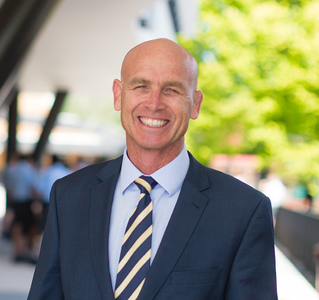From the Headmaster
The Anxious Generation - How the Great Rewiring of Childhood is Causing an Epidemic of Mental Illness
I don’t often get accused of being a luddite, but recently, I certainly am seeing the appeal. As a teacher, I have been a strong advocate for the use of technology at times, and have devised many learning experiences centred around the use of laptops, iPads, and different educational apps. I have seen the benefit of global collaboration with students, and seen the ease at which the “digital natives” (students) traverse new technology at a speed which can make me feel quite ancient. Yet in recent times, I have begun to pull back and with good reason.
I am hoping that as a parent, you may have seen the commentary around a new book called “The Anxious Generation: How the Great Rewiring of Childhood is Causing an Epidemic of Mental Illness” by Jonathon Haidt. The author has done the rounds of conventional media to coincide with the release of his book. His main point is simple – overprotection in the real world and under-protection in the virtual world are the major reasons why children born after 1995 have become the anxious generation.
What is anxiety? It is a term that at times is overused and used incorrectly. Anxiety is a both a normal reaction to stress and also a term for a mental illness where a person feels worried or overwhelmed by their thoughts. The former definition is a good thing. It is natural and safe to feel anxiety as one approaches a cliff edge, with a feeling of unease warning the body and the mind of the upcoming unsafe environment. It is also a natural feeling when a student has not worked on an assignment and it is due the next day. They will feel a normal and appropriate amount of unease which is anxiety. The latter definition is far more difficult to manage. Students with the mental illness are experiencing a disorder where they cannot regulate their thoughts and emotions, and are often left desperately affected. It is important that we do not conflate the two definitions.
So, what is the Anxious Generation? Haidt contends that new technology, more specifically, the smartphone, has accelerated social change for our teenagers at a rate far greater than society has been able to manage, and the side effects on a new generation are disastrous. It is far more likely that Haidt is talking about the increase in the first definition of anxiety, and also how as parents and adults, we can help.
Haidt contends that there are four “foundational concerns” that we should be aware of:
- Social deprivation: a smartphone is an “experience blocker”, taking up hours a day that would otherwise be spent in physical play or in-person conversations with friends and family.
- Sleep deprivation: too many teenagers stay on their smartphones late at night when they need rest.
- Attention fragmentation: alerts and messages continually drag teenagers away from the present moment and tasks requiring concentration.
- Addiction: apps and social media are deliberately designed to hack vulnerabilities in teenagers’ psychologies, leading to an inability to enjoy anything else
(Source: The Conversation.com)
I have seen firsthand each of these concerns rise dramatically over the course of my career. The use of smartphones, particularly in the last five years, has exploded out of control with a recent report stating that teenagers spend up to seven and a half hours on a device EACH day (Source: Common Sense Media). Whilst there is nobody who would advocate that that much screen time is acceptable, the hidden cost is one that Haidt expresses so articulately. This screen time comes at the expense of vital activities that protect and shield our youth from mental illnesses. Activities that teach resilience, positive risk taking, and knowledge building are all replaced with quick fix dopamine hits and doom scrolling. Gone are the days of after school hang outs, kids riding bikes to their friend houses, climbing trees, walking to the park. These are all a casualty of the addiction and “experience blocking” of these devices. Now TikTok dances, YouTube reels, and a glut of fast food information is digested quickly for no real benefit. This applies to us as adults as much as it does to our children.
The good thing in all this doom and gloom is that the solution is also known:
- Allow your son to experience unstructured, unsupervised play. Encourage him to ride his bike to the park with a friend, give him the responsibility of buying something from the shops for you.
- Monitor your son’s screen time (Settings>Screen Time). Check how many notifications they are receiving each day and teach them how to turn all notifications off.
- Early to bed! A 15 year old teenage boy needs 8 to 10 hours of sleep a day. Don’t allow them up past 10pm, not for any reason other than they need the rest!
- Take a digital break. The school holidays are a great opportunity to help detox and set up new habits. Start small, for example have them leave their phone outside their room at night.
- Allow your son to develop healthy risk-taking behaviours. This is the hardest one to manage. By allowing your son to learn how to take risks safely, and sometimes fail, he develops resilience, courage, and strength of mind. Think back to when the Government so wisely removed monkey bars from schools as they were too “risky”. What followed was a generation of kids who never tested their strength, hung upside down, learnt to fall safely. A little bit of risk is good for growth….
As a College, we are moving in this direction to assist you as parents in this important task. We are using laptops only when required and have moved back to a written workbook so that students can not be distracted by their devices. We have a College policy that no mobile phones should be seen at school – they must be kept in lockers. And we are actively engaged in creating experiences that build safe risk taking and independence into our camp and retreat programs.
Servo fidem
Liam Stakelum
Acting Headmaster














